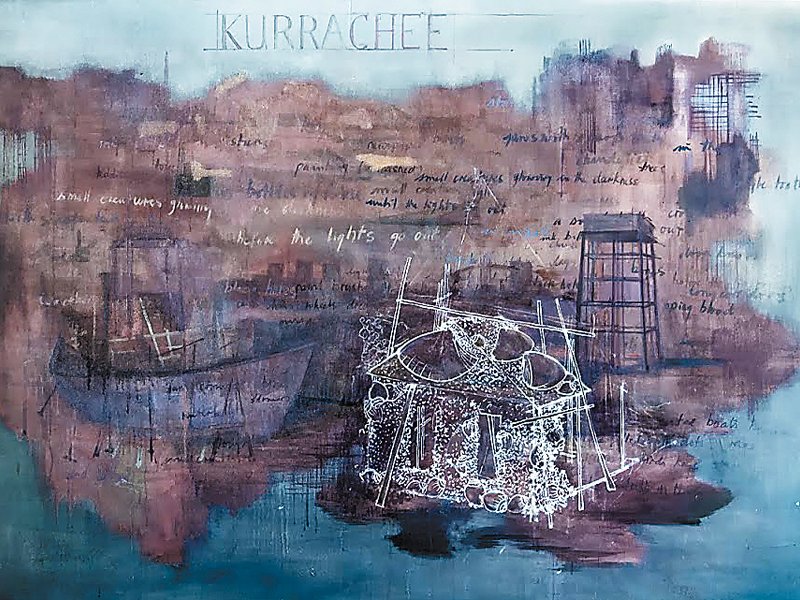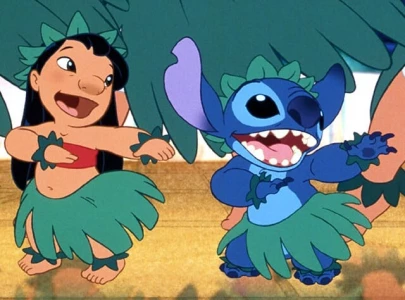

A standstill from a video 'Homage', where Khan painted pieces of broken furniture surrounded by rubble. Photo courtesy: Koel Gallery
Movies, check. Photographs, check. Sculptures, check. Paintings, check. Charcoal sketches, check. Poetry, check. Khan, in her most recent exhibition ‘The Weight of Things’ at the Koel Gallery, is just short of grabbing a guitar and playing a mean solo while tap-dancing as she managed to inspire and mesmerise in equal measures through almost every other artistic medium imaginable.
The works
If you look at her painting ‘How We Mark the Land Becomes Part of its History’, you can easily miss the ‘k’ in ‘mark’, so that it reads: ‘How we mar the land becomes part of its history’. Considering Khan’s sheer genius, this might be a deliberate ploy to give her painting the most apt title. If you start at the bottom, the sketch portrays a tent and the sea, followed by lines of blurred text and finally a city landscape. The text seems to be the countless stories of this city and how they have marked and marred the city and changed it from serene to sprawling, from being calm to being calculated.

‘Building Terrain’ is from Naiza Khan’s photography collection and shows the stark contrast between two of her photos. Photo courtesy: Koel Gallery
Clearly an artist who is just as gifted with the pen as she is with the brush, her painting ‘Small Creatures Glowing in the Dark’ was a fan favourite - not only for the beautiful name but also for the text inside it. The painting has the word ‘Kurrachee’ written in bold at the top, followed by ‘Small creatures glowing in the dark before the lights go out’ written twice. The small creatures seem to be the people of Karachi but ‘dark’ and ‘light’ can be interpreted in a multitude of ways - from the literal to the proverbial. Former artist Paro Alam looked at the painting with fondness. “This gives me a feeling that I belong to this city,” she said with a smile.

‘How we mark the land becomes part of its history’ is a charcoal painting that shows the change in Karachi through the years. Photo courtesy: Koel Gallery
Khan claimed that her work ‘Constellations Adrift’ was her personal favourite. “This piece includes nearly 225 separately carved brass items,” she told The Express Tribune. “I had to personally sit with a welder to make them.” She explained it has a sense of disruption, it has clusters inside of it and the work is disjointed.
A mischievous twinkle flashed across her eyes when she used the word ‘disruption’, as if chaos was her favourite theme. And it was apparent in her works. The blurred lines on the painting, the wiped out stories of her sketch, the broken boats in her photo - every work highlighted and celebrated the lack of a pattern.

The disruption is, however, best seen in her video ‘Homage’. Khan paints a piece of broken furniture in the ‘ruins’ of Manora. Amidst the rubble, the bright blue pieces of broken wood highlight the disruption of the area around it as much as they highlight the flashy paint job.
Khan manages to capture the city in her work - she captures its anarchy and turns it into art.
And the crowd goes wild
A Mughal lamp burned at the entrance, a man with a ponytail smoked a cigarette while leaning on a table, soft music played in the background - one could somehow sense that most people at the gallery were artists or at the very least fancied themselves as one. However, it was just as important to take the opinion of the layman as it was of the artisans.
“This reminds me of a Beatles song,” said architect Shahid Khan before almost bursting into song. “I’d like to be under the sea in an octopus’ garden, in the shade.” The picture he was pointing at ‘An Invisible Landscape Conditions the Visible One’ had an octopus in the corner in a heap of garbage.
“I would not put any of these in my house,” said a girl, who refused to tell her name after being told that she might be quoted for what she had just said. “I am sure these paintings have some sort of aesthetic value but I just don’t see it. They are all so confusing.”
Published in The Express Tribune, January 25th, 2014.
COMMENTS (1)
Comments are moderated and generally will be posted if they are on-topic and not abusive.
For more information, please see our Comments FAQ


1732519298-0/BeFunky-collage-(85)1732519298-0-165x106.webp)
1732611352-0/lamar-(5)1732611352-0-165x106.webp)
1732610018-0/BeFunky-collage-(91)1732610018-0-165x106.webp)

1732603037-0/BeFunk_§_]__-(51)1732603037-0.jpg)
1732610150-0/Untitled-design-(3)1732610150-0-270x192.webp)

1732610854-0/Untitled-design-(68)1732610854-0-270x192.webp)
1732608486-0/BeFunk_§_]__-(54)1732608486-0.jpg)






If nobody except the artist understand the drawing, it is called modern art. Modern art is not made by human hands, but the tails of donkeys and horses. Of course, many got awards.